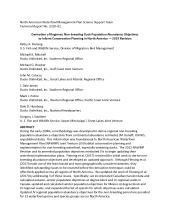
ABSTRACT
During the early 2000s, a methodology was developed to derive regional non-breeding population abundance objectives from continental abundance estimates (M. Koneff, USFWS, unpublished data). This information was foundational to North American Waterfowl Management Plan (NAWMP) Joint Venture (JV) habitat conservation planning and implementation for non-breeding waterfowl, especially wintering ducks. The 2012 NAWMP Revision and its amended population objectives motivated JVs to begin updating their waterfowl implementation plans. Fleming et al. (2017) revisited the initial work to derive non-breeding abundance objectives and developed an updated approach. Although Fleming et al. (2017) made use of the least biased and most geographically consistent datasets, they identified outstanding issues to be resolved before the derivation technique could be effectively applied across all regions of North America. We updated the work of Fleming et al. (2017) by addressing 3 of those issues. Specifically, we incorporated Canadian harvest data and calculated autumn–winter population objectives at degree block and JV-regional scales in Canada, updated and calculated winter population objectives for Mexico at degree block and JV-regional scales, and expanded the list of species for which objectives were calculated. Updated JV regional population abundance objectives for the non-breeding period are provided for 23 waterfowl species and species groups across North America.
